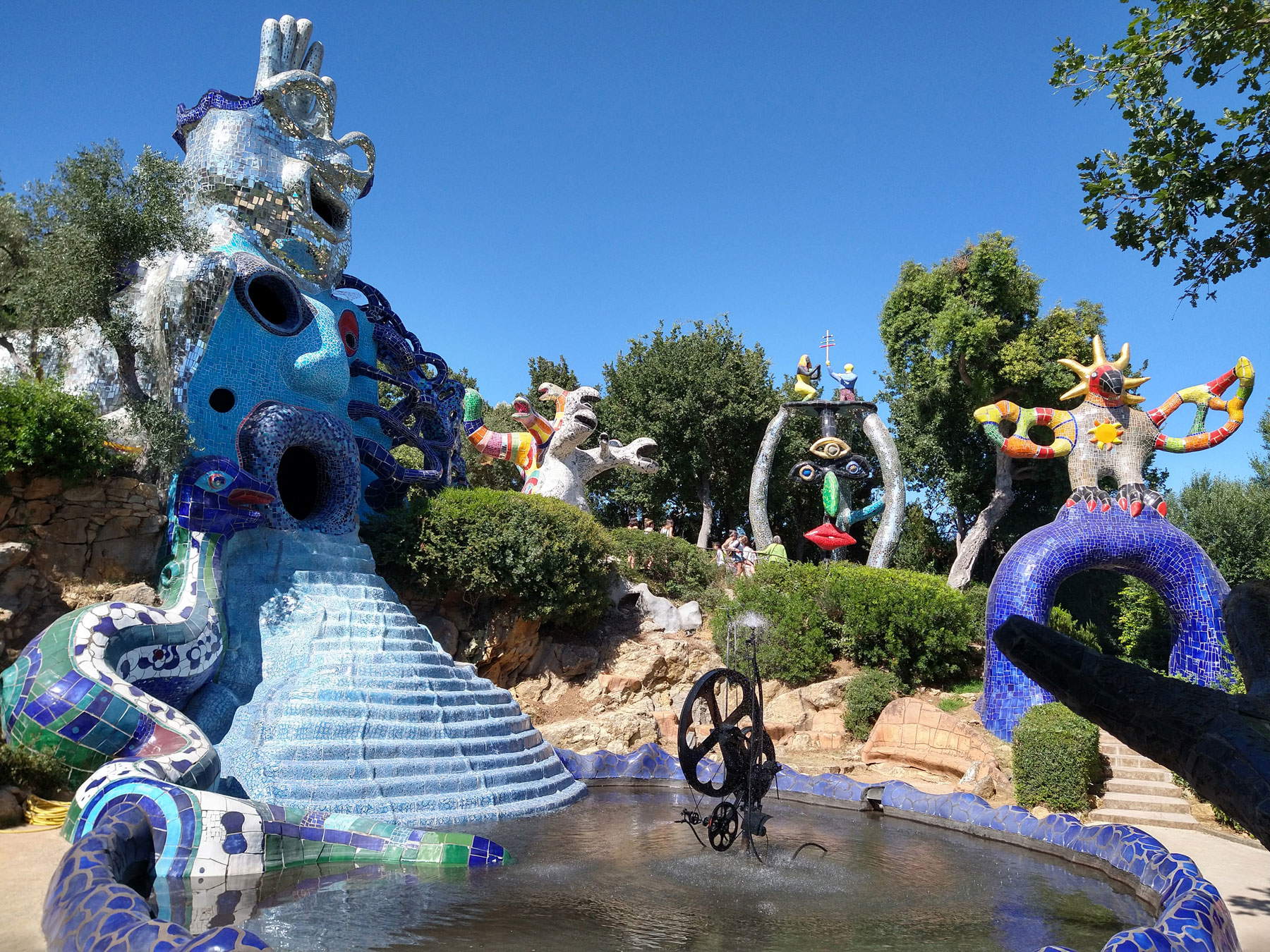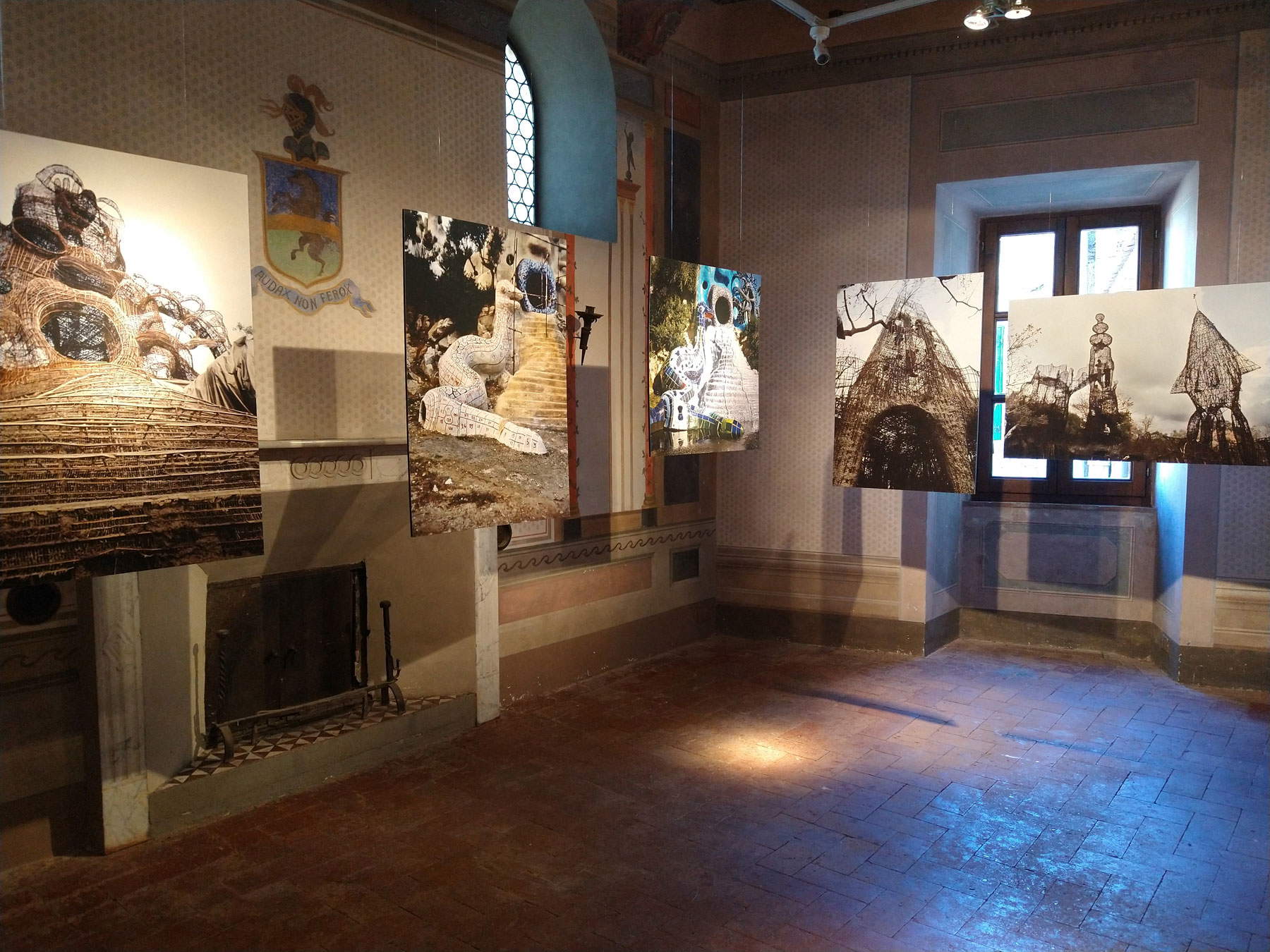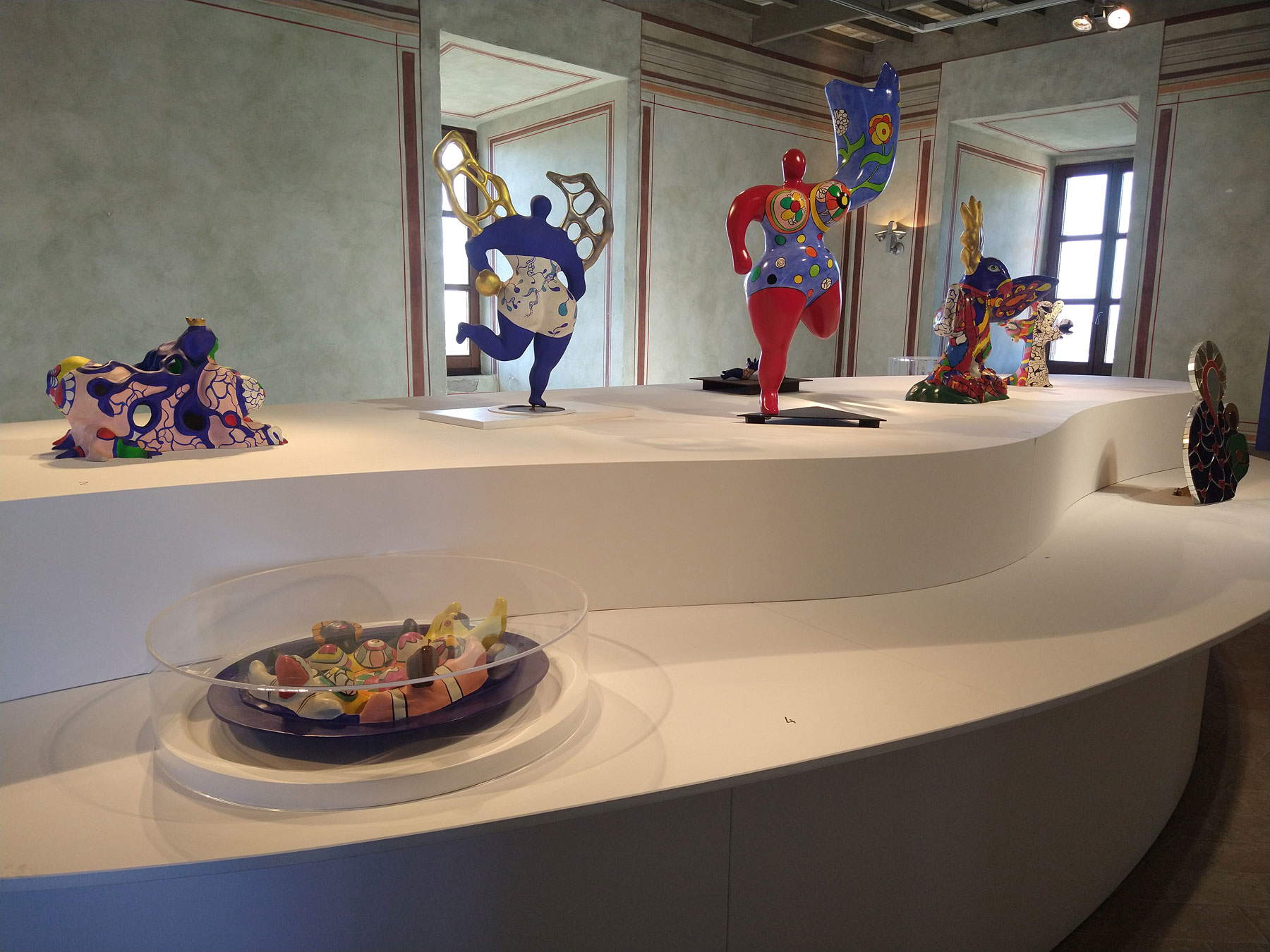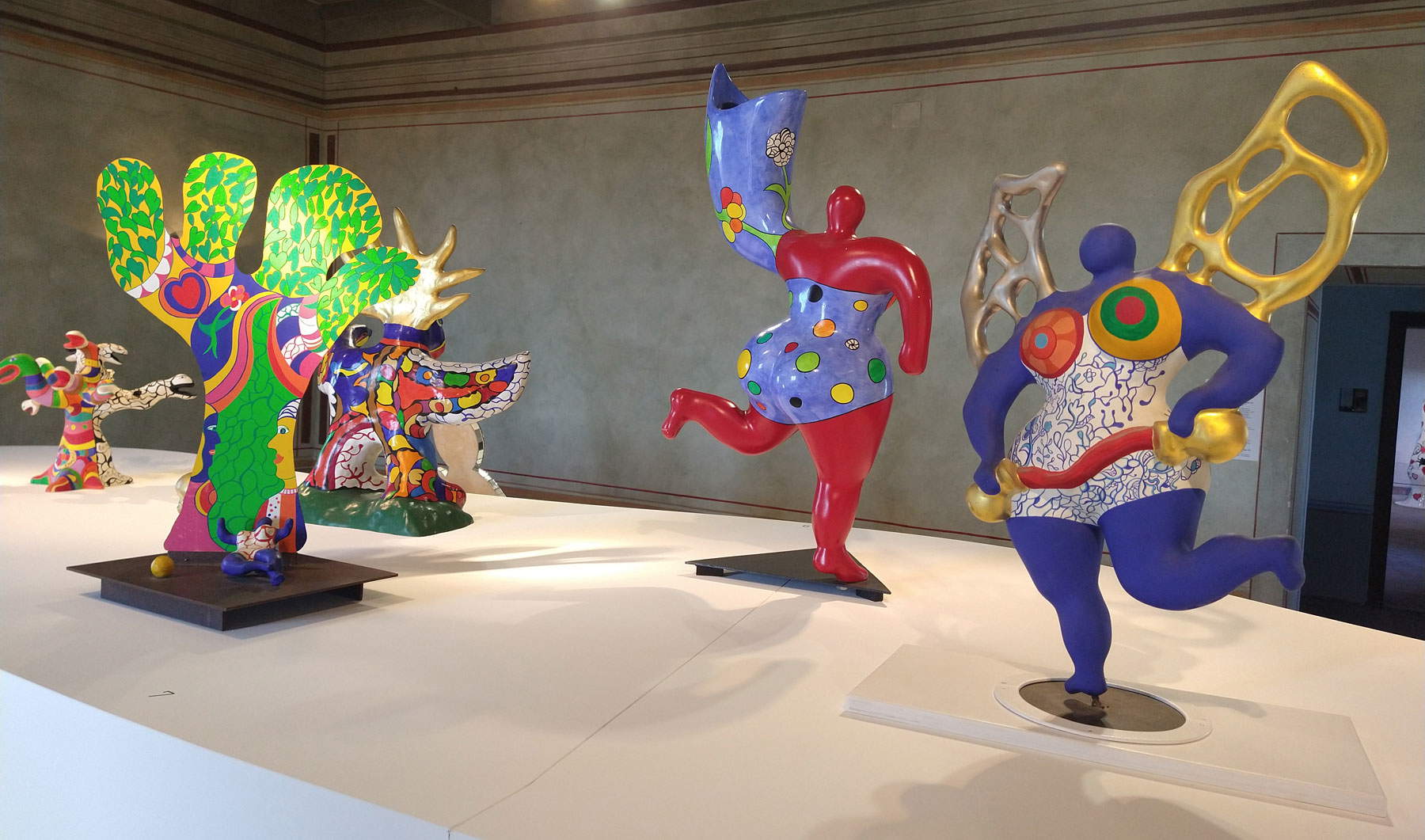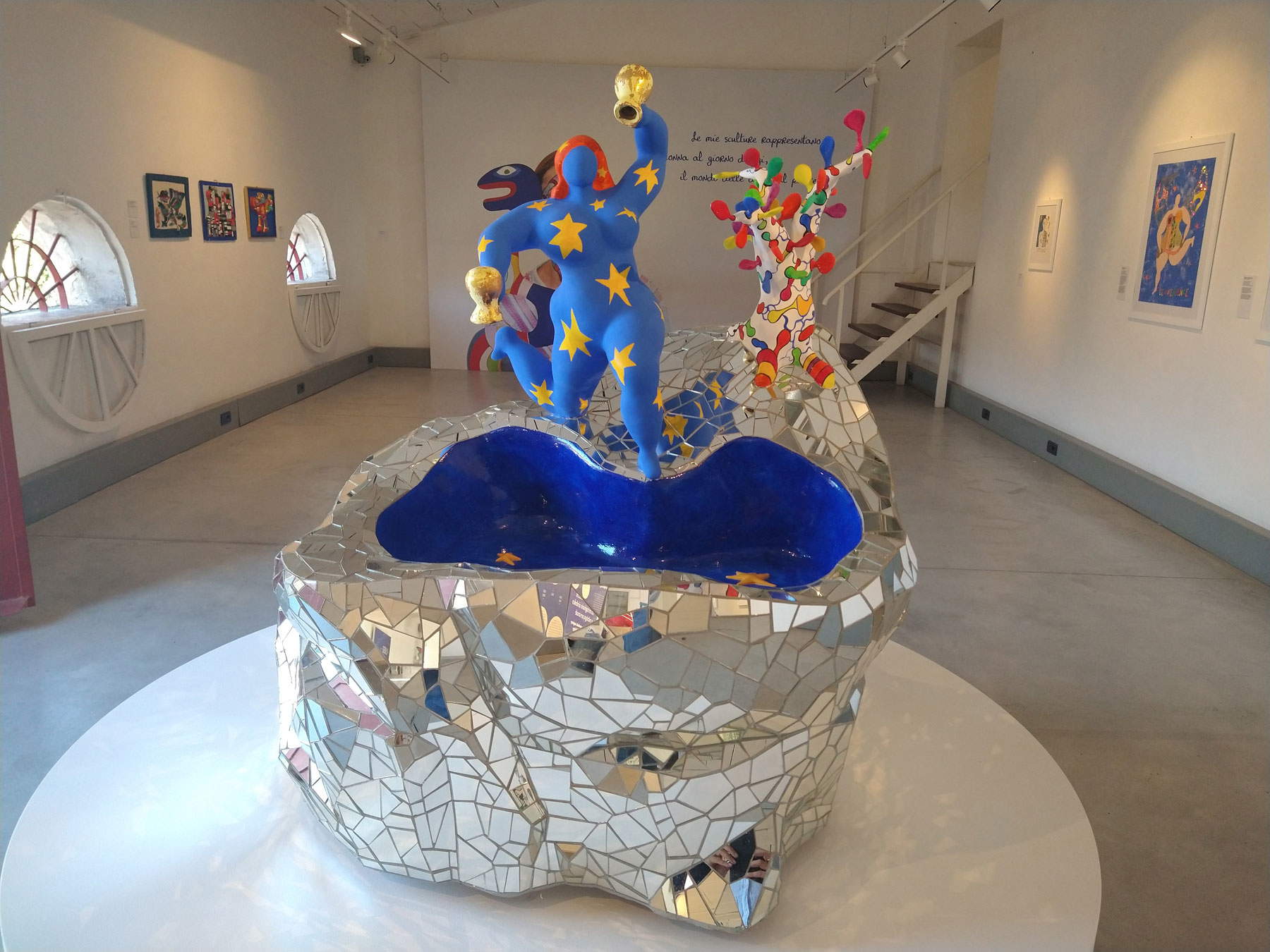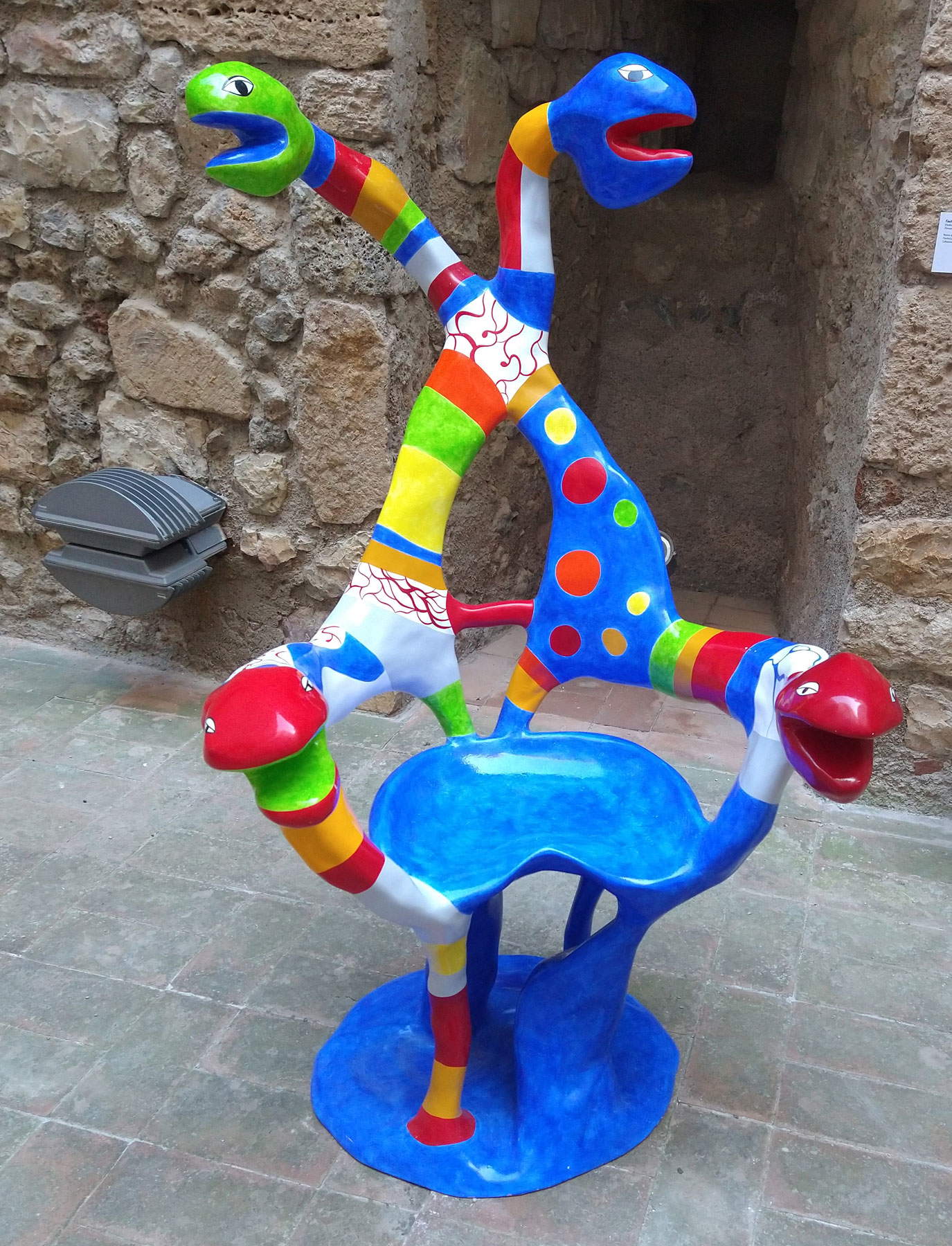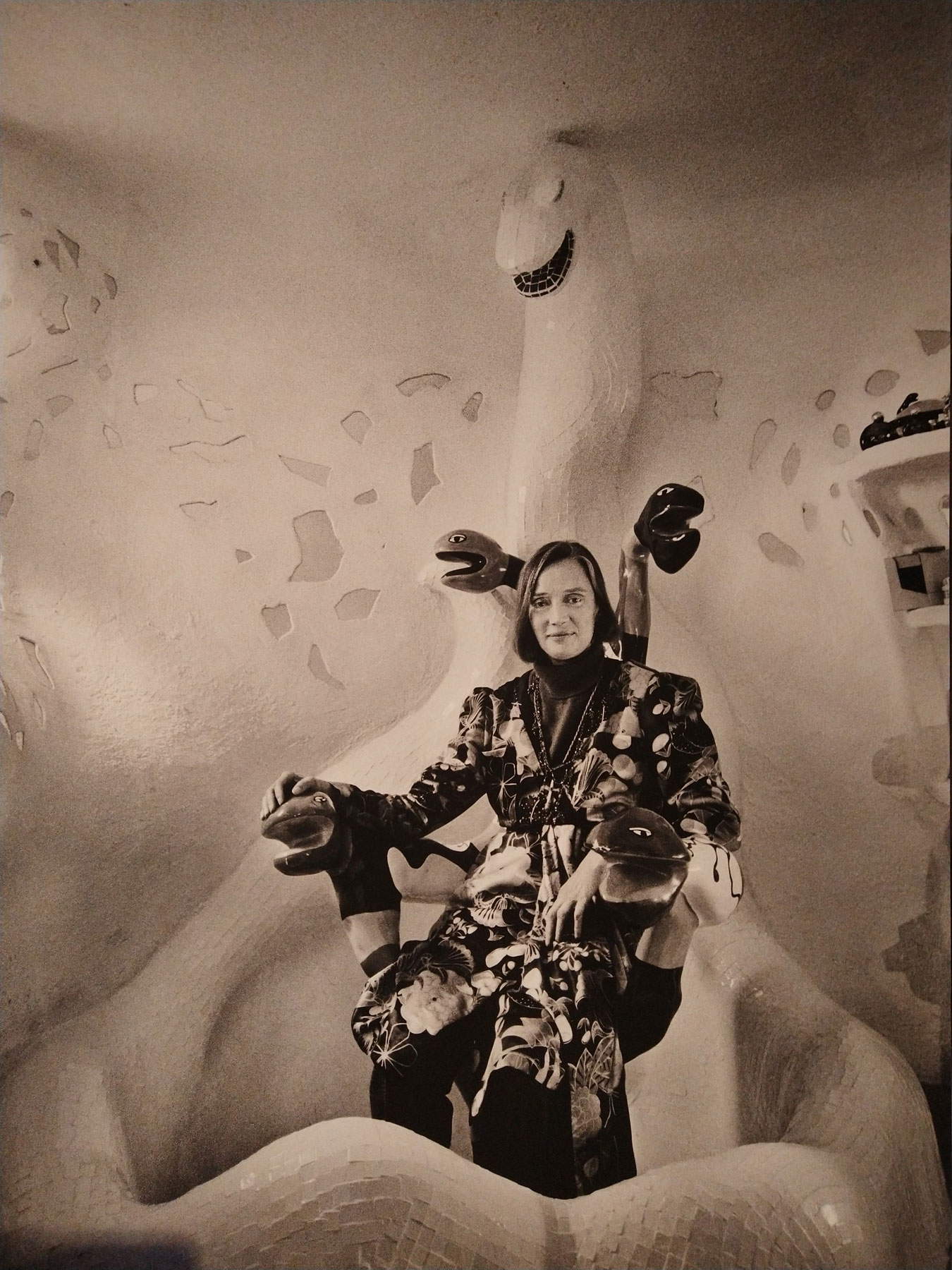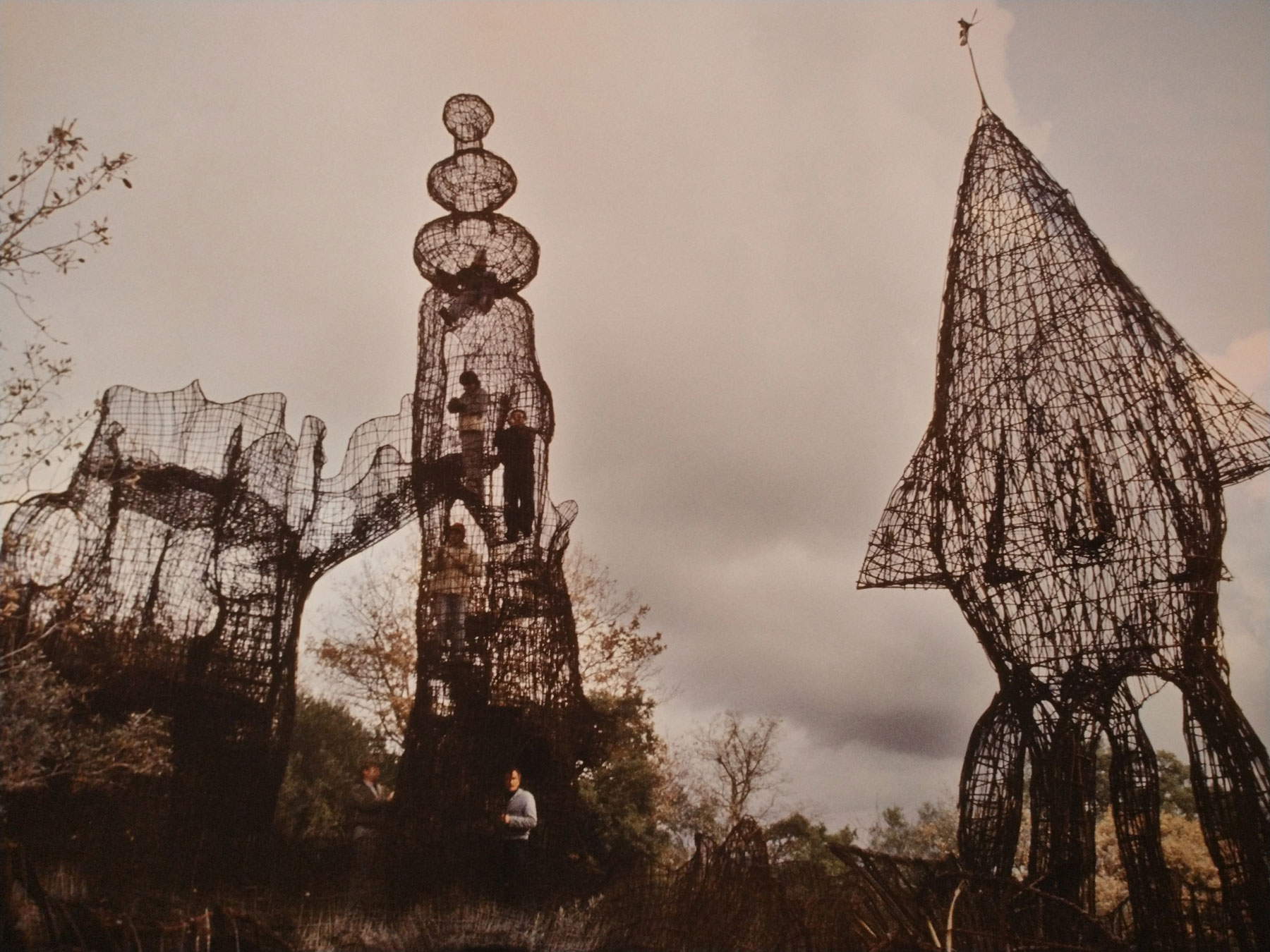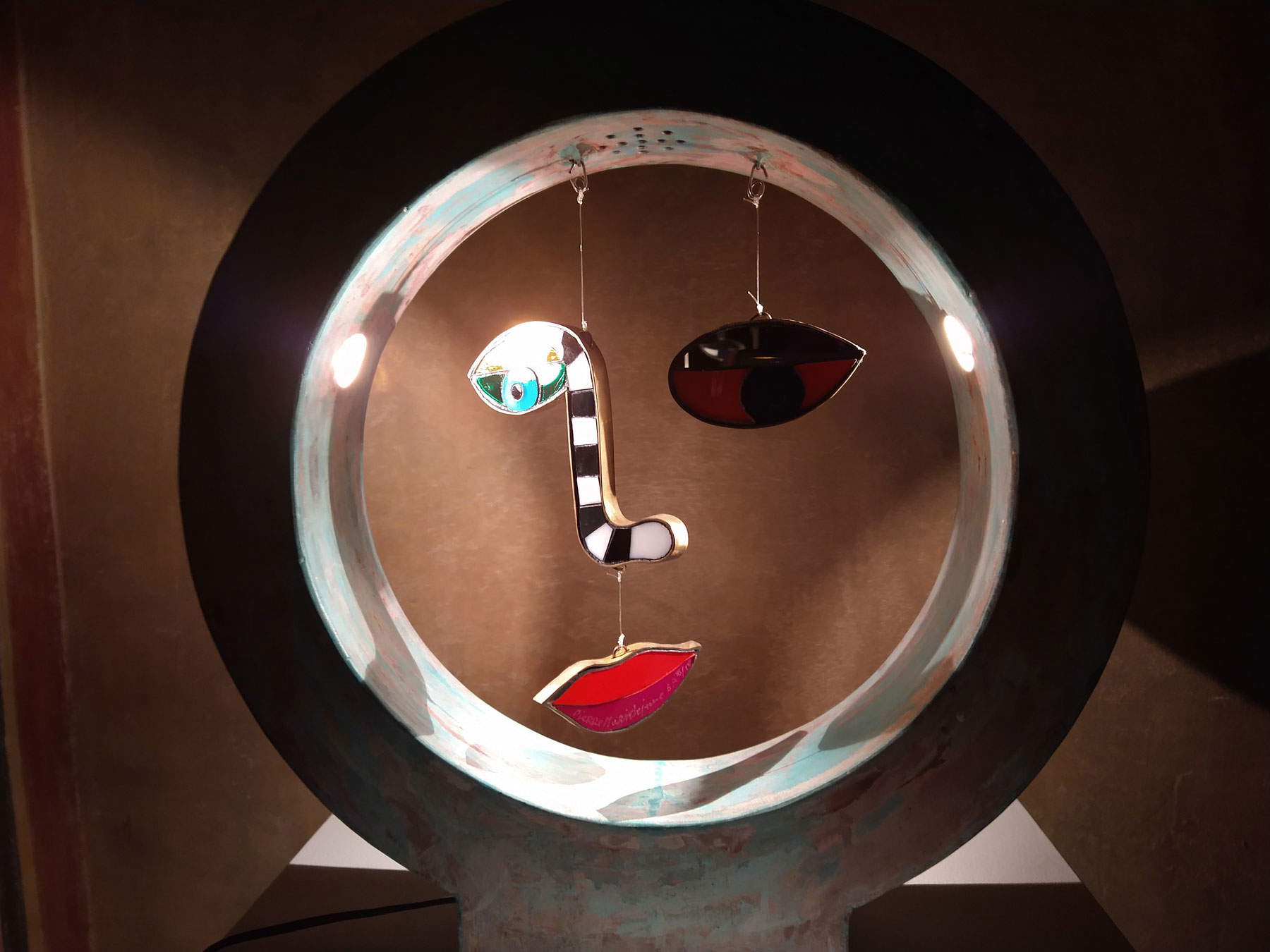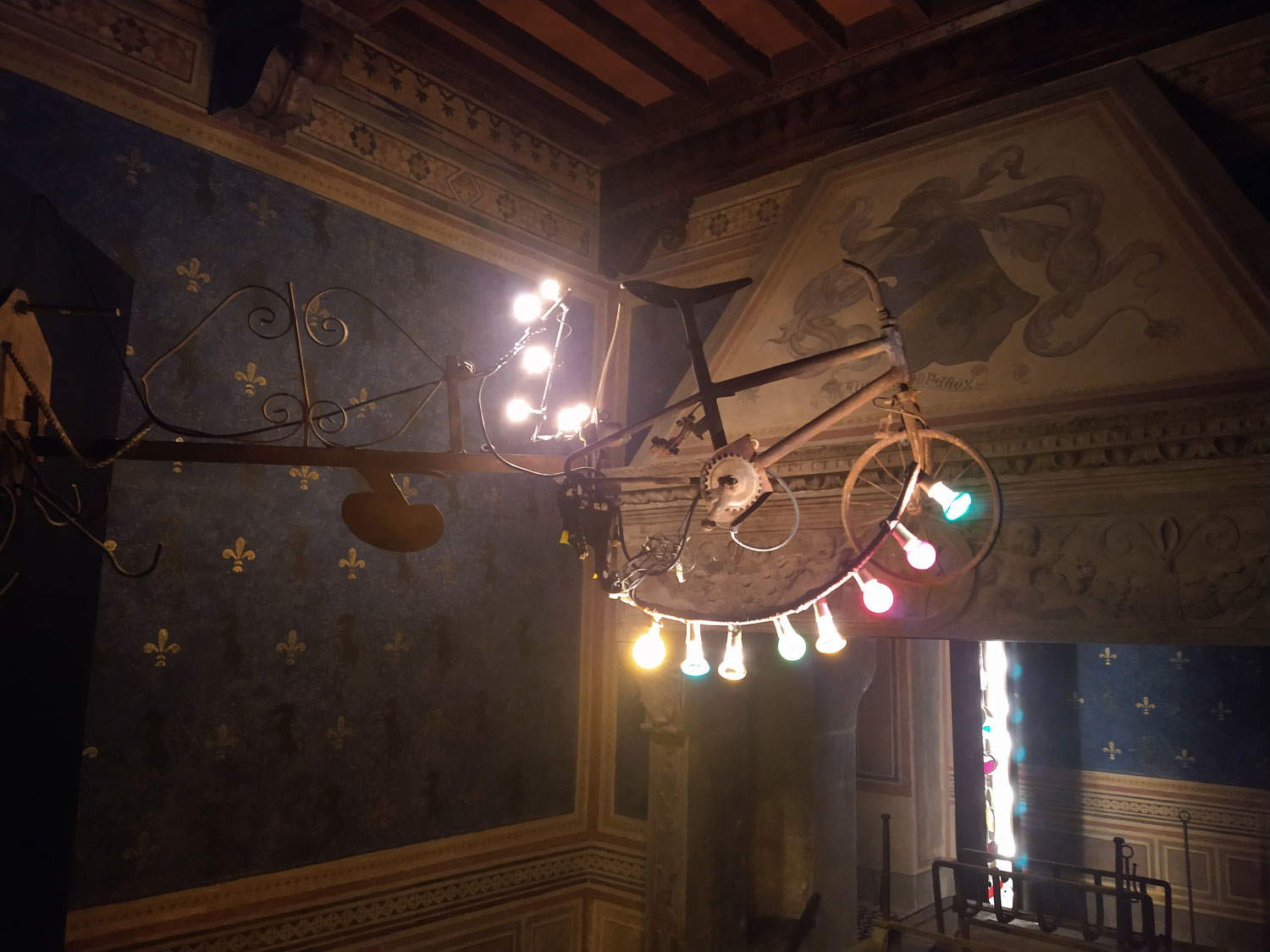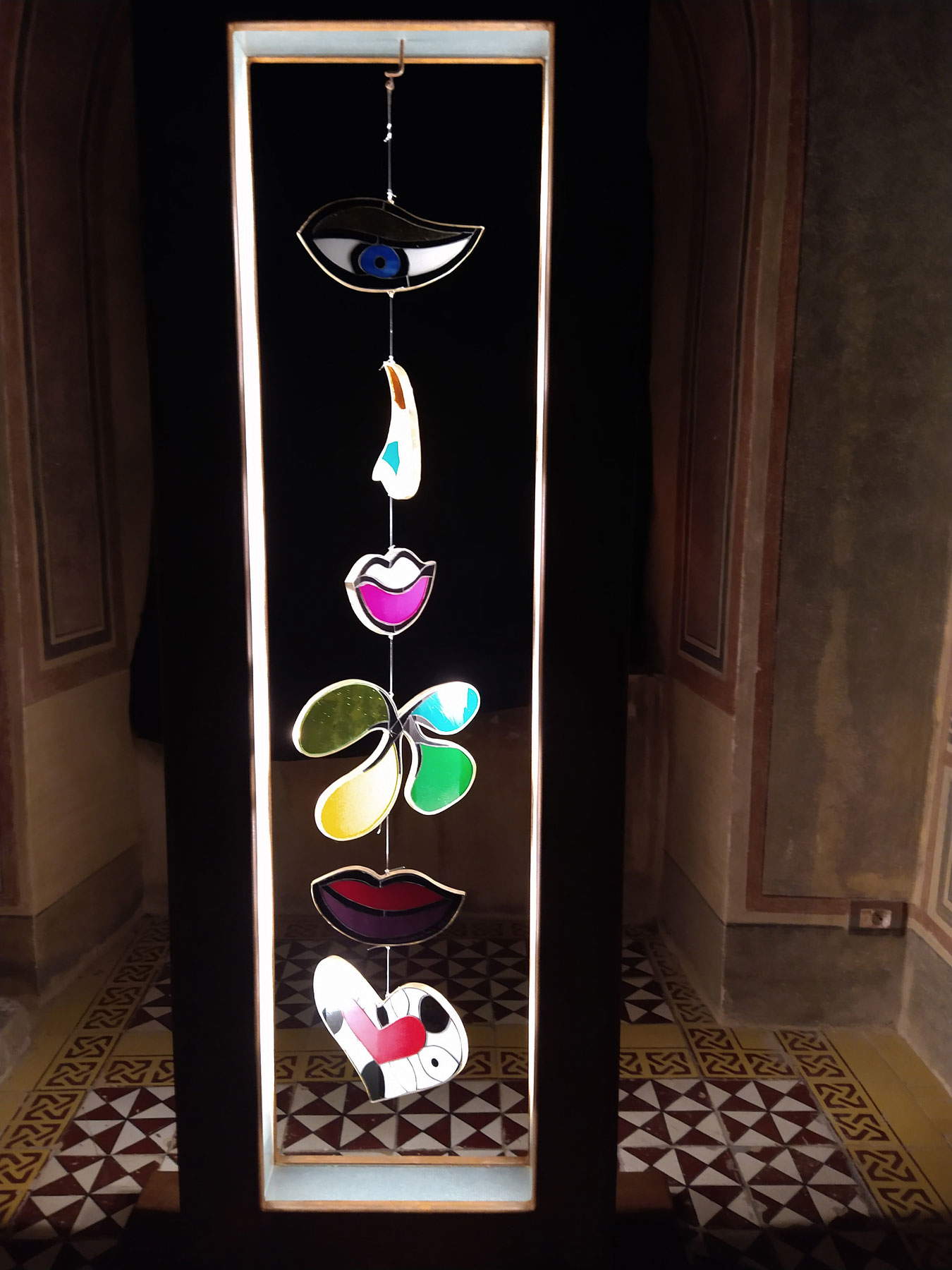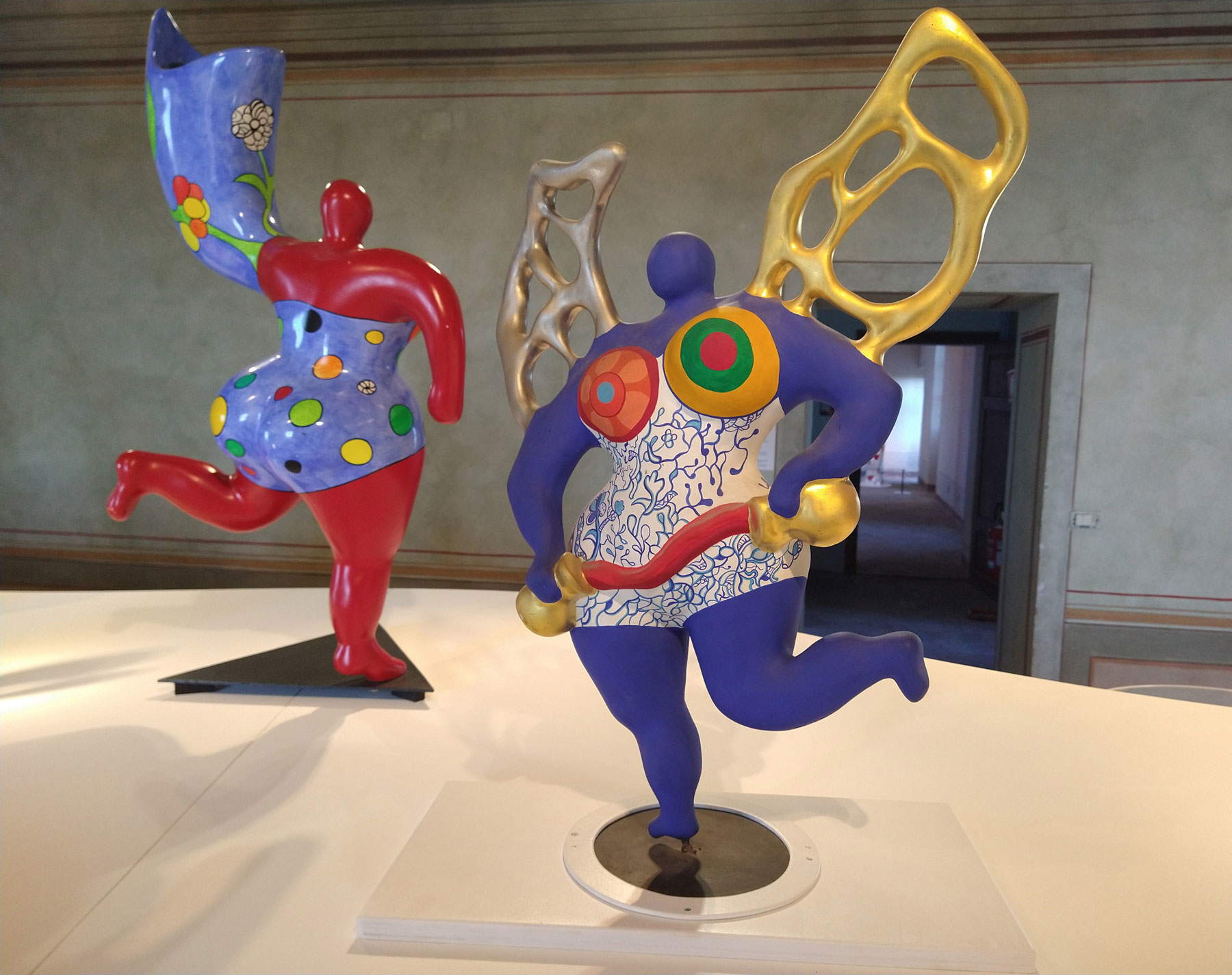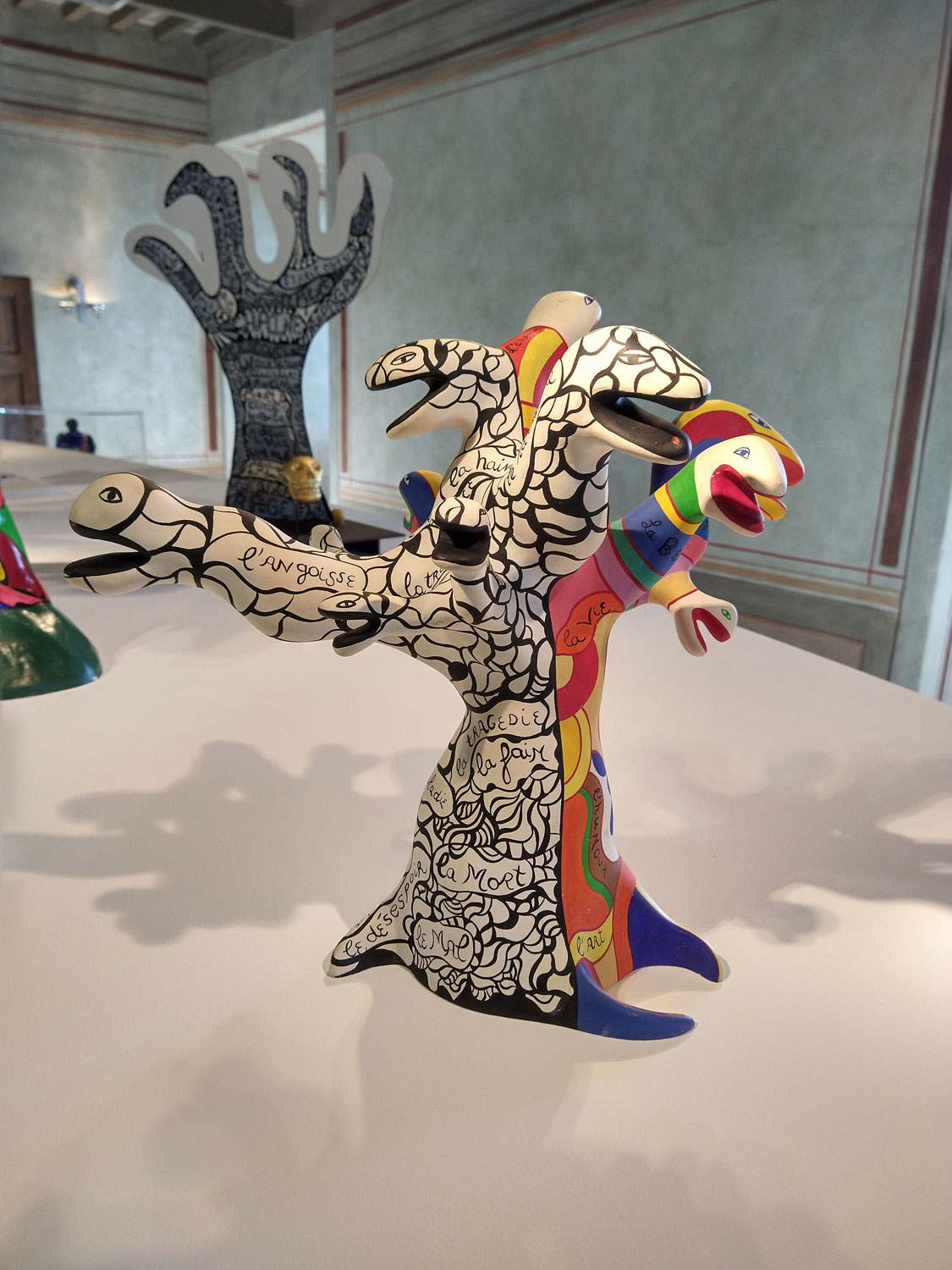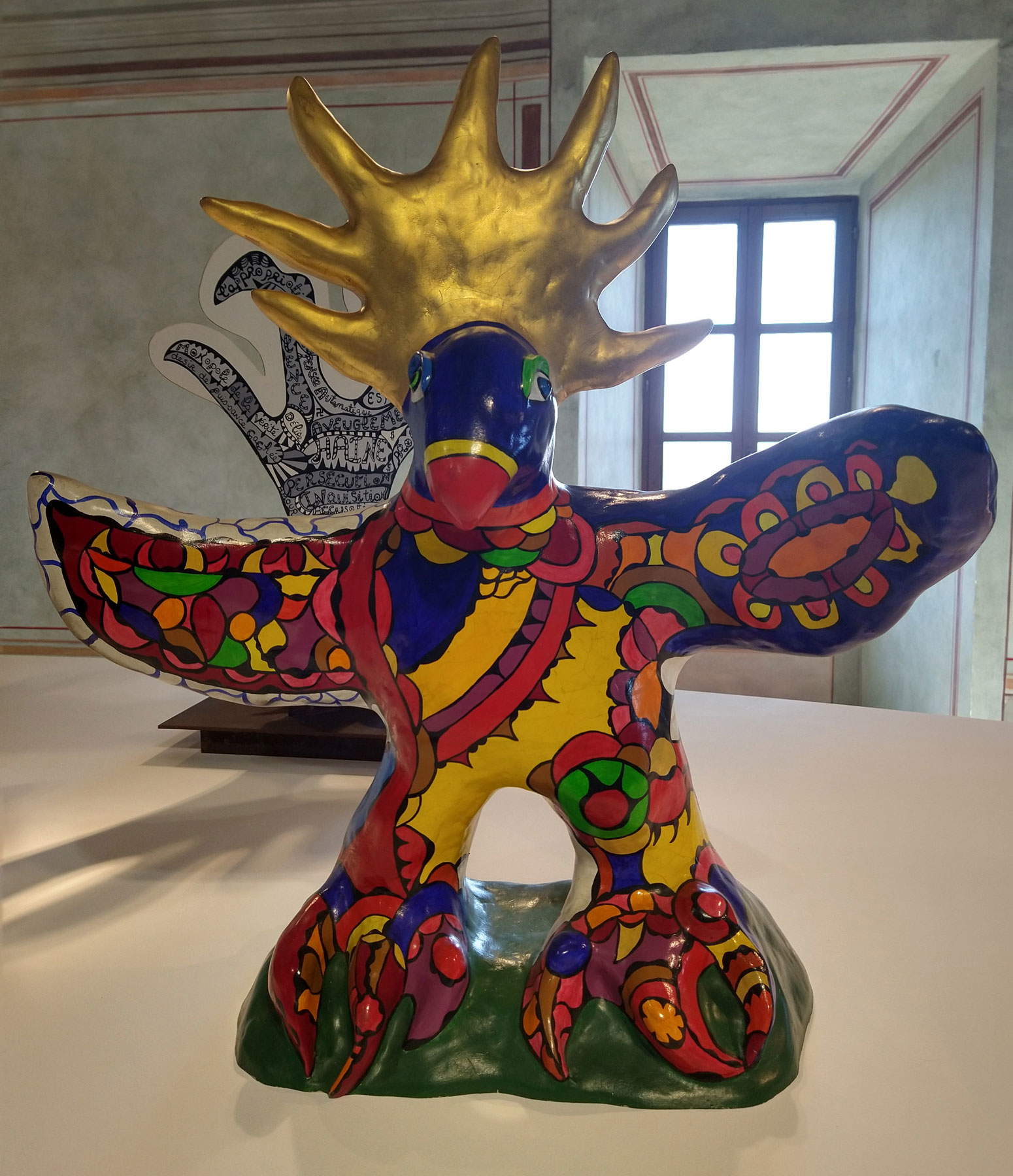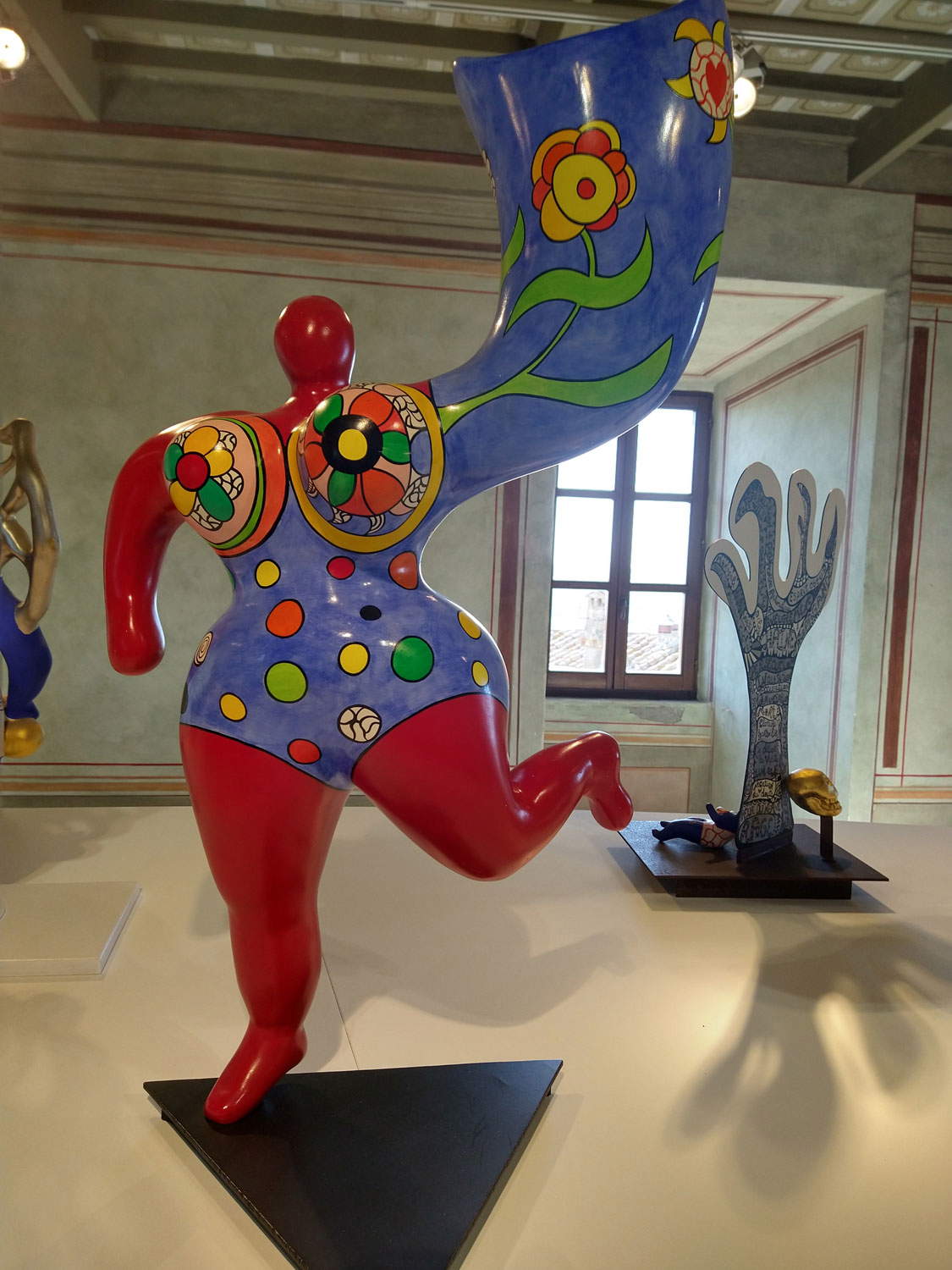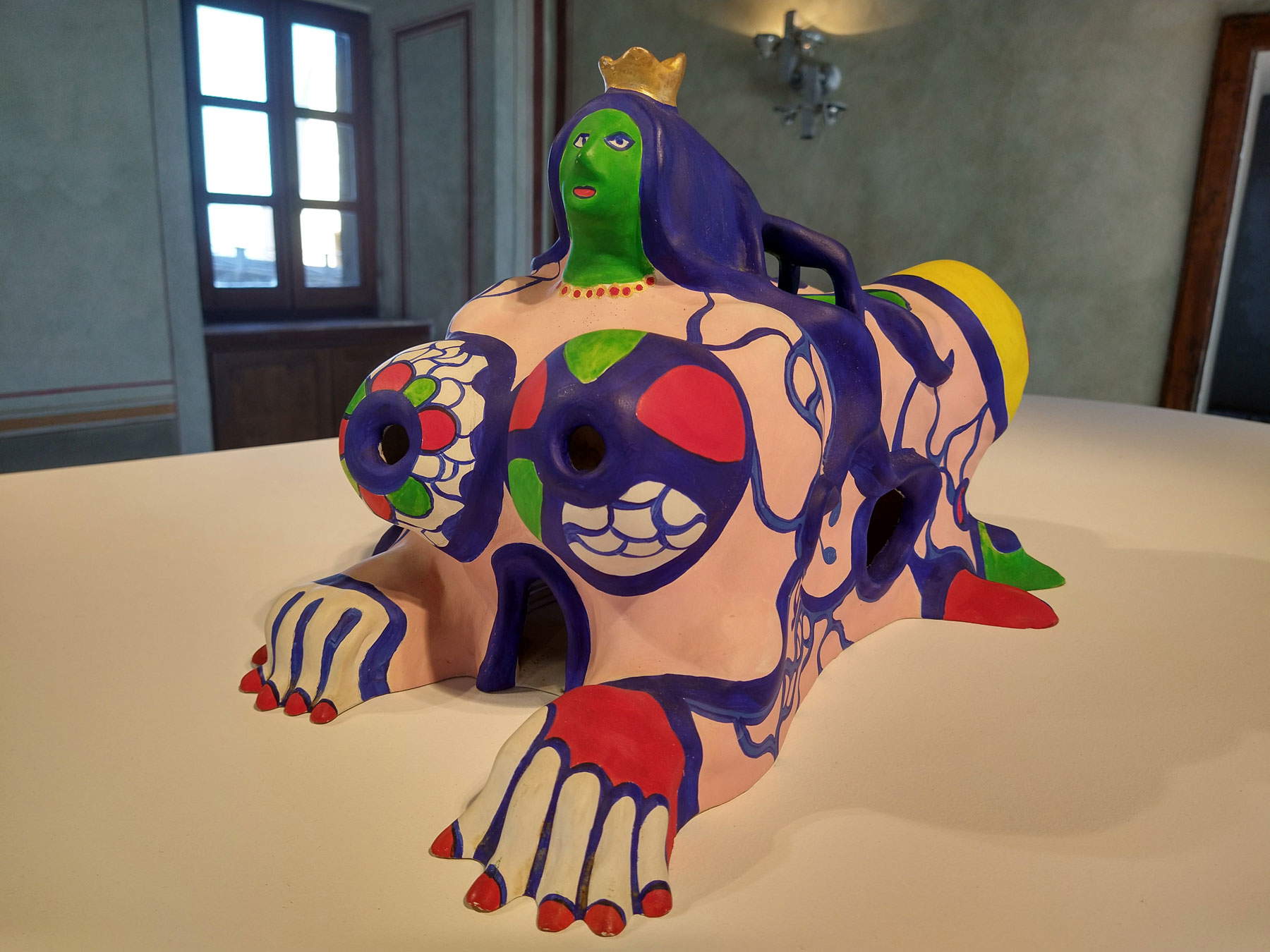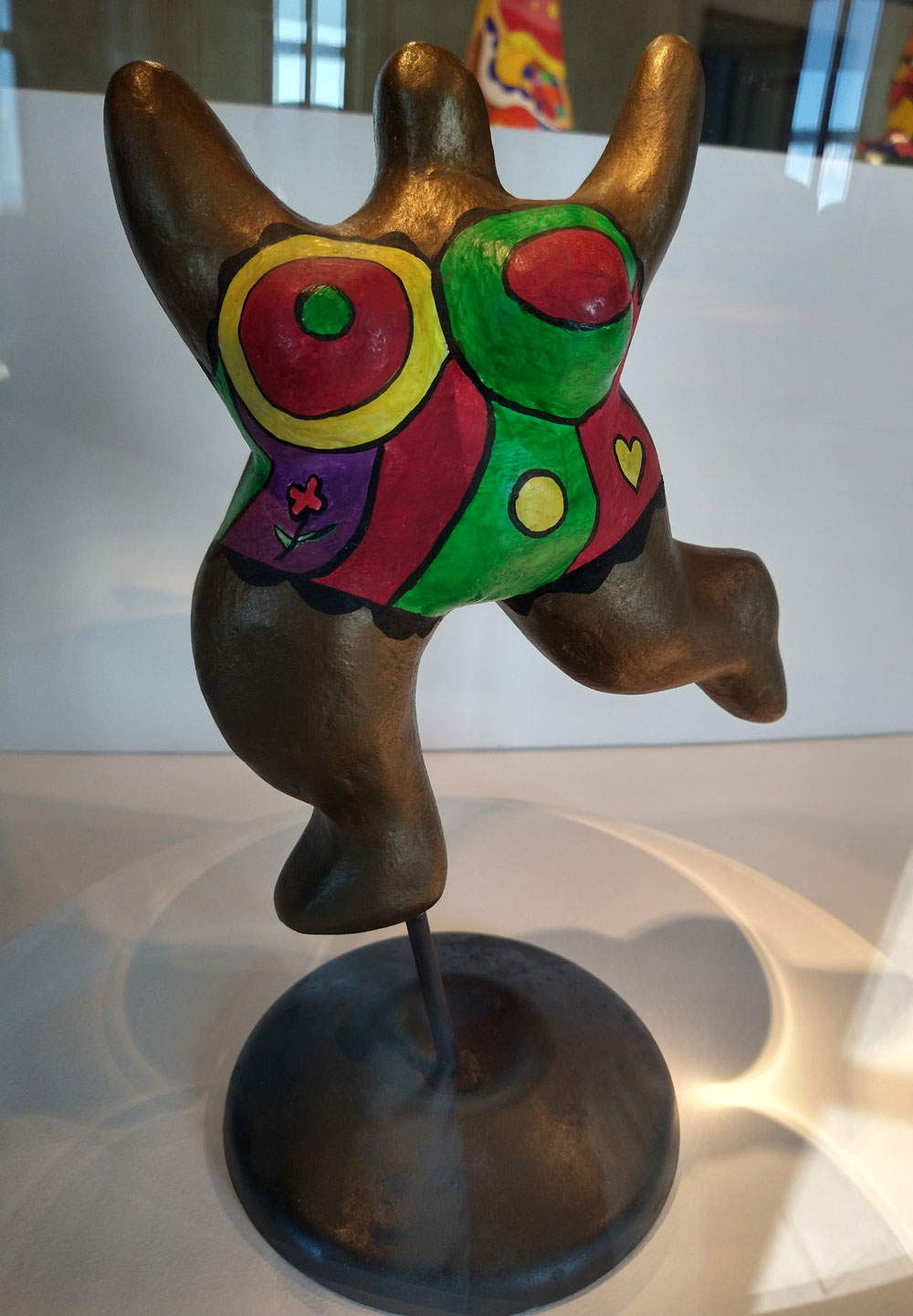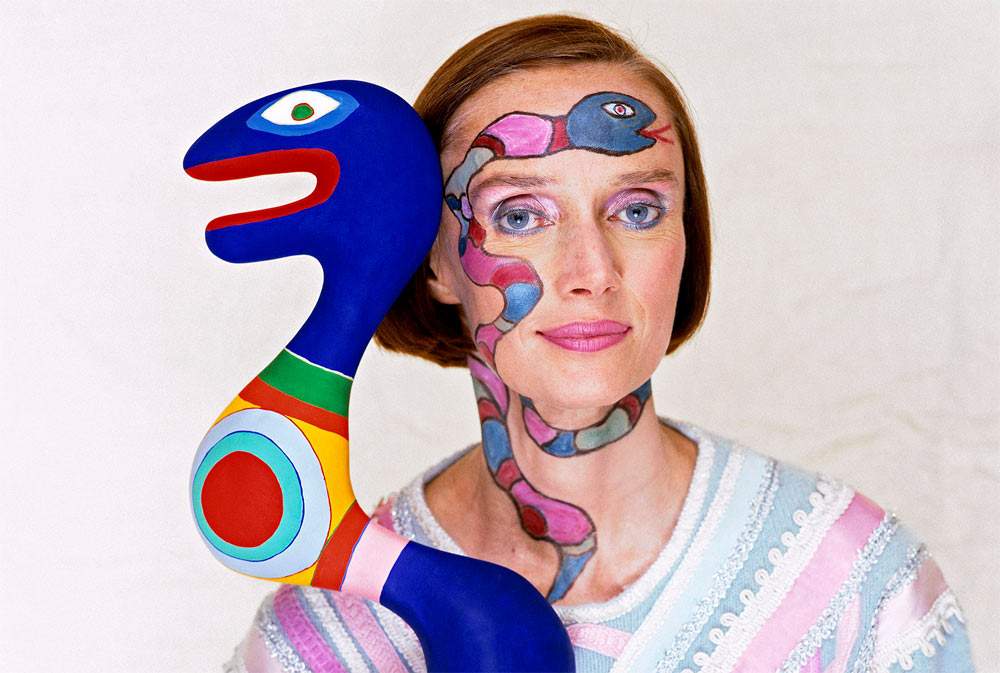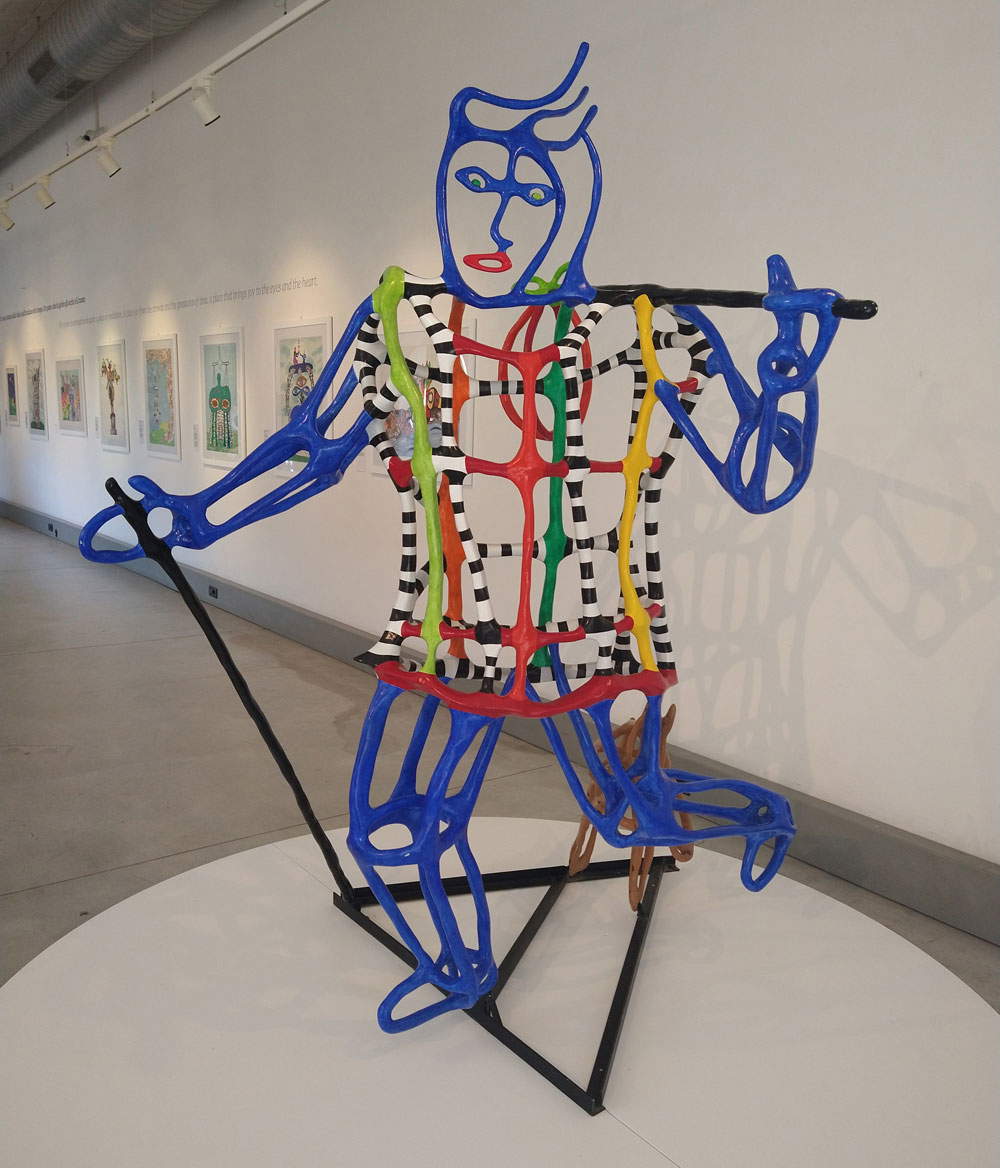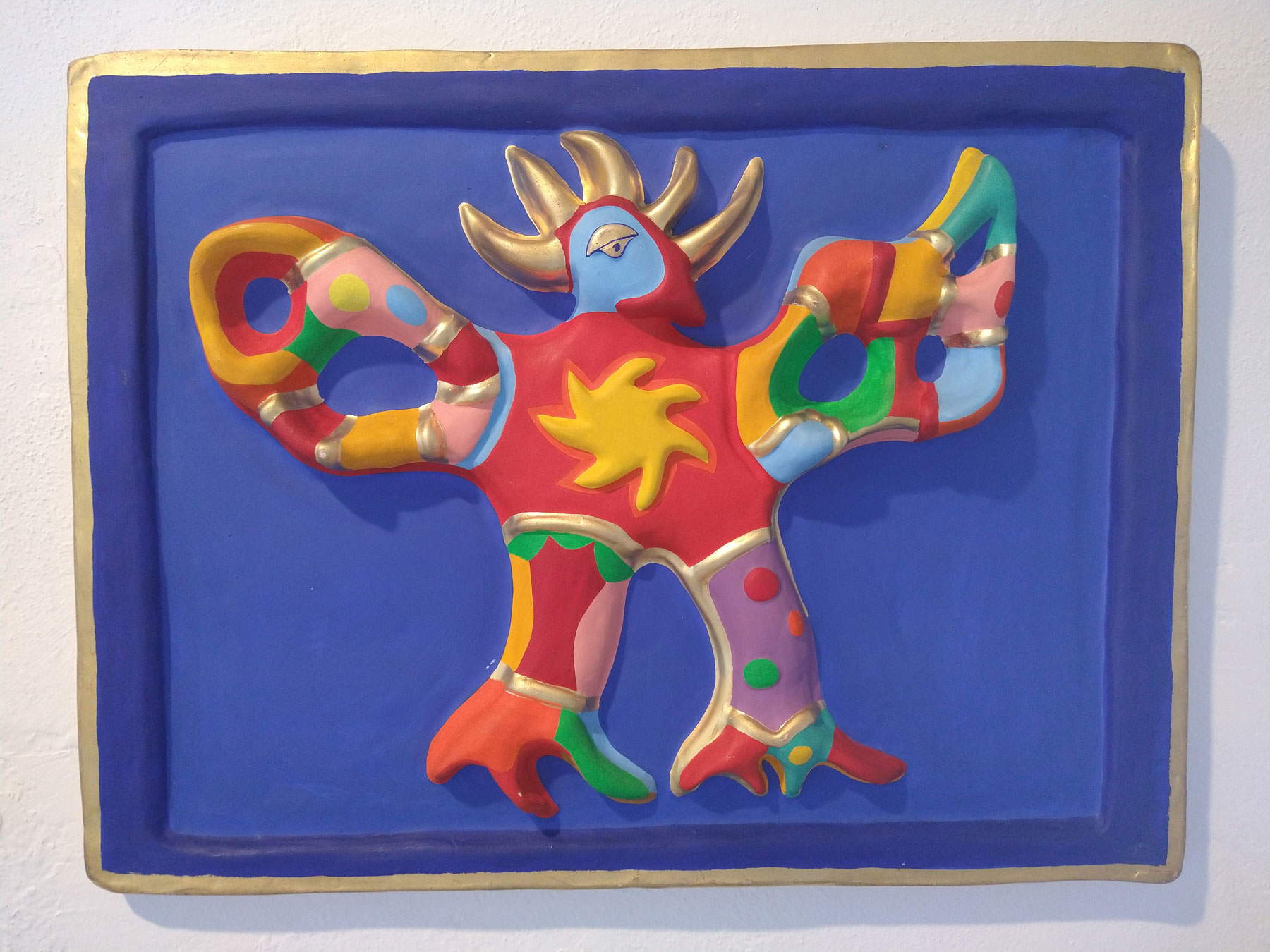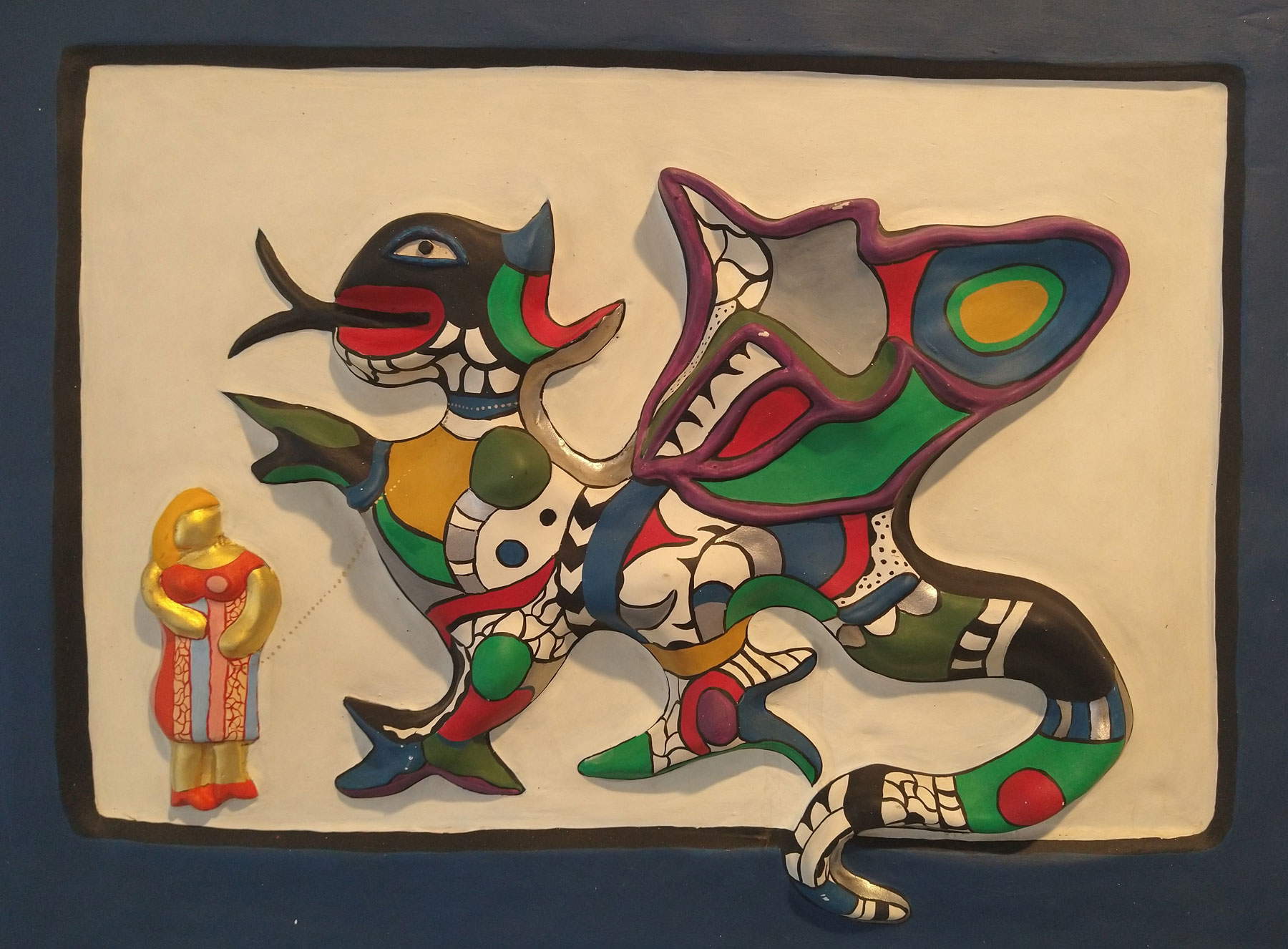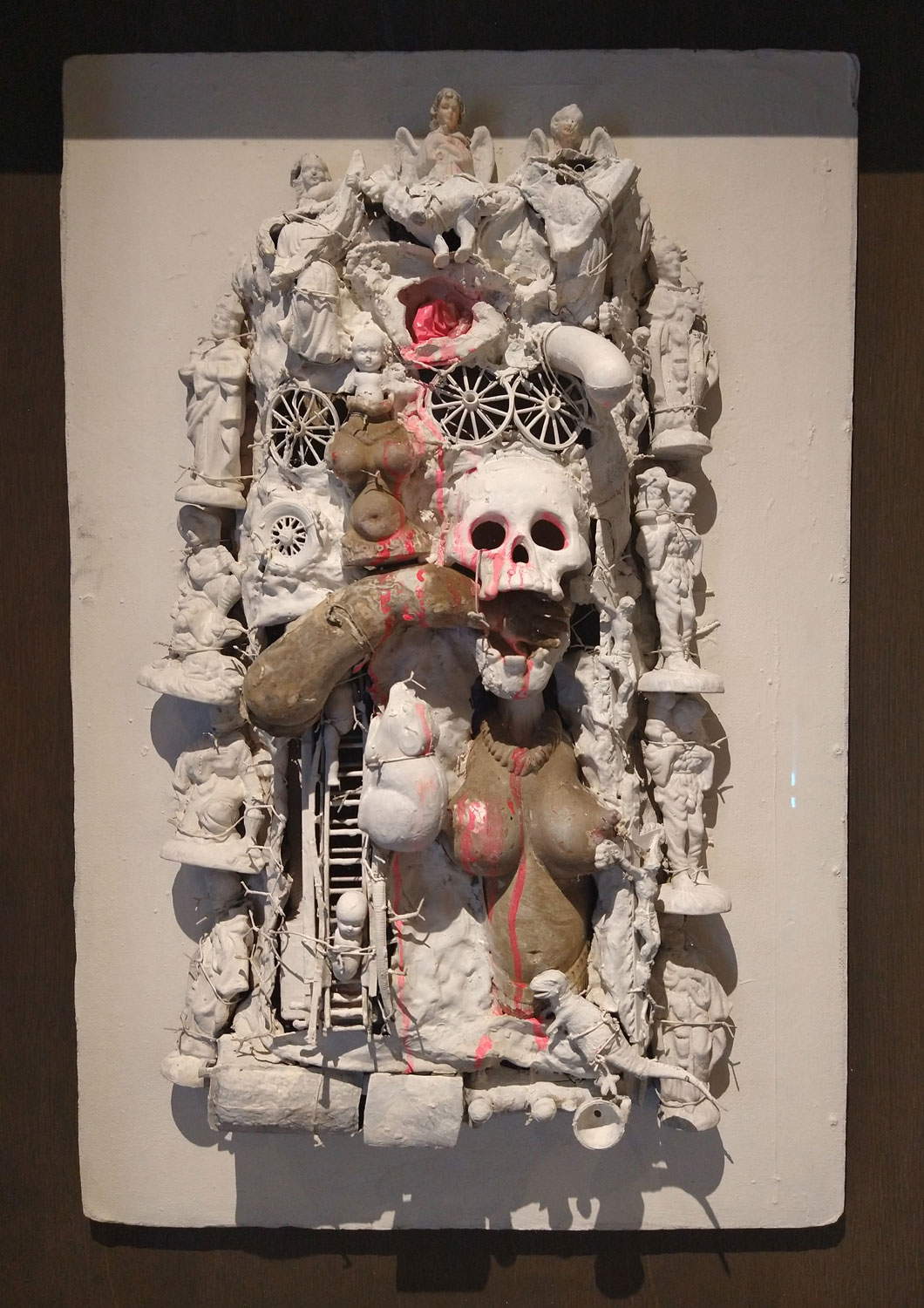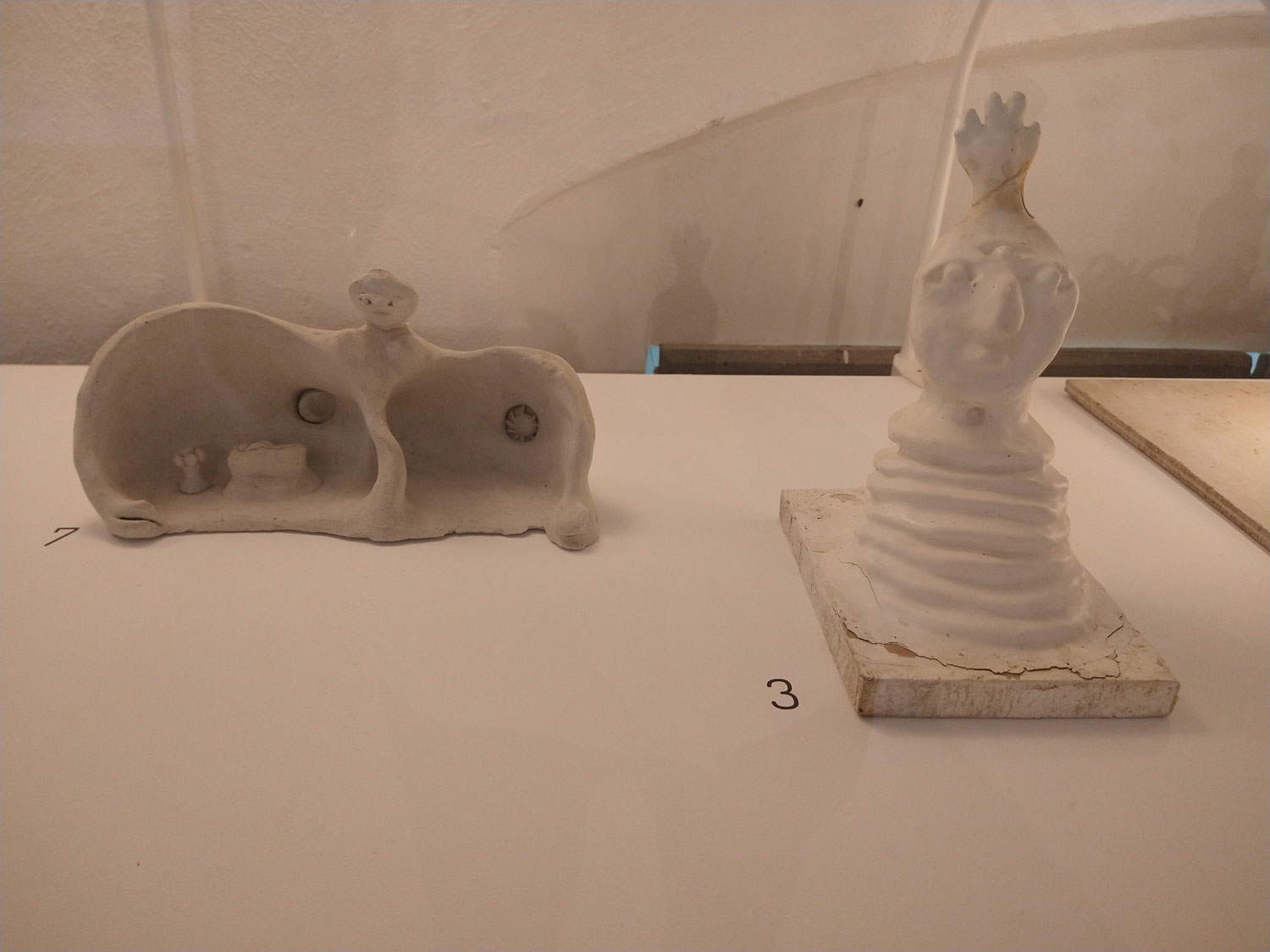by Ilaria Baratta , published on 10/08/2021
Categories: Exhibition reviews
/ Disclaimer
Review of the exhibition "The Place of Dreams: Niki de Saint Phalle's Tarot Garden," in Capalbio, Palazzo Collacchioni and Il Frantoio Gallery, through Nov. 3, 2021.
Among the summer and early autumn exhibitions, the one in Capalbio dedicated to Niki de Saint Phalle (Neuilly-sur-Seine, 1930 - La Jolla, 2002), the French-American artist who created near one of Italy’s most beautiful villages, in the province of Grosseto, the art park that could be considered our own Parc Güell , is definitely worth a visit. She herself confesses this at the entrance to her Tarot Garden in a letter to visitors: the ambitious and complex idea of creating a park as a total work of art and as a kind of initiatory journey was inspired by her visit at the age of twenty-five to Gaudí’s famous park in Barcelona, but also by the Park of Monsters in Bomarzo. A dream come true that she planned and financed completely on her own, but which she realized with the help of her collaborators, with whom she built a beautiful relationship of friendship, for a collective project where the absolute protagonist is Art.
The major diffuse exhibition curated by Lucia Pesapane, entitled The Place of Dreams: the Tarot Garden of Niki de Saint Phalle, which can be visited until November 3, 2021 and is organized by the Municipality of Capalbio in collaboration with The Tarot Garden Foundation, The Niki Charitable Art Foundation and the Capalbio Foundation, runs over two exhibition venues in the ancient village: Palazzo Collacchioni and Il Frantoio Gallery. However, it is advisable, if not necessary, to visit, before the widespread exhibition, the Tarot Garden, not only because it is an unmissable experience if you are in these parts, but also because the exhibition project is closely related to it. Through this enjoyable exhibition, the Municipality of Capalbio pays homage to Niki de Saint Phalle’s strong artistic relationship with the village (she was also given honorary citizenship), exemplary evidence of which is still her Garden. Treating oneself to a visit to the diffuse exhibition therefore means approaching Niki’s artistic universe in the complexity of its structure, and then better understanding that extraordinary and elaborate project that gave life to one of Italy’s most spectacular art venues. In addition to Saint Phalle’s articulated artistic universe, one also has the opportunity to understand her world from a human point of view, based on the concepts of inclusion, participation, friendship, collaboration and on themes such as the sharing of universal and community values, the defense of rights, the idea of a united and progressive Europe, and the urgency of issues related to ecology and climate change. In the face of all this, the realization of the Garden was for the artist the creation of a better place, where to give space to an empathetic society, rich in values, that becomes aware of the importance of community, against the arrogance and overpowering that dominate in the political, economic and social system. “I dream of dwelling in a space without borders”: this was her dream and from here she set out to try to create it, herself.
 |
| The Tarot Garden. Photo Finestre Sull’Arte |
 |
| Hall of the exhibition The Place of Dreams: the Tarot Garden by Niki de Saint Phalle (Palazzo Collacchioni) |
 |
| Hall of the exhibition The Place of Dreams: the Tarot Garden of Niki de Saint Phalle (Palazzo Collacchioni) |
 |
| Hall of the exhibition The Place of Dreams: the Tarot Garden of Niki de Saint Phalle (Palazzo Collacchioni) |
 |
| Hall of the exhibition The Place of Dreams: the Tarot Garden of Niki de Saint Phalle (Il Frantoio Gallery) |
The diffuse exhibition, to be seen as mentioned above together with the Garden, is afull immersion into the life, art and mind of Niki de Saint Phalle, which is aimed both at those who already know a little about this independent and avant-garde woman and artist, a dreamer, but also stubborn and combative in advancing her values in which she firmly believes, and at those who are aesthetically fascinated by the art park then intend to delve deeper into all that lies behind it.
Between the two venues in the ancient village of Capalbio, more than one hundred works are brought together on this occasion, including sculptures, drawings, videos, and photographs, some of them unpublished and never before exhibited to the public, encompassing a time span from the 1960s to the 1990s. In the Palazzo Collacchioni venue, the history of the Tarot Garden, from the beginning of its construction, is retraced in various sections, with images, videos, sculptures, maquettes, and collages; in the Galleria Il Frantoio venue, historical works by the artist are also on display to provide an additional element of knowledge about his art.
Starting at Palazzo Collacchioni, the exhibition introduces visitors to the history of the Garden project: how Niki was so fascinated by Gaudí’s Parc Güell in Barcelona that she decided to build a fantastical garden capable of bringing joy to visitors and proposing a model of community life through art. The sculpture park, which is considered one of the greatest expressions of contemporary environmental art, was created between 1978 and 1998 and is inspired by the twenty-two major arcana of the Tarot: these, in addition to being a card game, also, indeed above all, constitute a teaching of life; in this sense, visitors who enter the Garden go through an initiatory journey, whose stages, represented by the monumental sculptures, mark the fundamental points for an inner change. The invitation to dwell on the introduction is made explicit by some colorful seats placed in the Palace’s outdoor courtyard, of which the snake is a characteristic element, also frequent in the park.
Entering the first exhibition room, visitors are greeted by a series of photographs that testify to the construction site initiated by the artist on land that the Caracciolo brothers made available to her within their property in Garavicchio. As documented by the images on display, Niki first made models of the sculptures in terracotta, which were then enlarged to full scale with the help of Jean Tinguely (Freiburg, 1925 - Bern, 1991) and Doc Winsen. The armatures of the sculptures were made of steel bars welded and bent into arms thanks to a team of collaborators; wire lattices were placed on the steel structures to support the concrete, the numbered, fired and glazed ceramics, and the pieces of mirror arranged in a mosaic pattern. The entire Garden thus took shape and color, and for a few years the artist chose to live inside theEmpress, the great goddess, protective mother and sacred magic, to whom Niki gave the form of a sphinx. Even today it is still possible to enter the Empress’ charter to realize the incredible apartment the artist had created, complete with dining room, kitchen, bathroom (there is a photo where Niki is in the shower sitting on the Serpent chair) and bedroom. The park was inaugurated and opened to the public in 1998 and can still be visited seven months a year to ensure its preservation.
 |
| Niki de Saint Phalle, Fauteuil Ser pent (1992; painted epodissic resin; The Tarot Garden Collection) |
 |
| Niki de Saint Phalle on the Serpent Chair in the Empress Shower (1985; Niki Charitable Art Foundation) |
 |
| Welds in the Emperor’s Towers (1982; Niki Charitable Art Foundation) |
 |
| Niki de Saint Phalle, Visage (1999; patinated brass, glass mosaic and mirror, low-intensity electric light; Paris, Galerie Messine) |
 |
| Jean Tinguely, Lamp (1993; iron and colored bulbs; Il Giardino dei Tarocchi Collection) |
 |
| Niki de Saint Phalle and Pierre Marie Lejeune, Mobile (1999; steel, glass, glass mosaic and mirror, low-intensity electric light; Paris, Galerie Messine) |
 |
| Two sculptures by Niki de Saint Phalle |
 |
| Niki de Saint Phalle, L’Arbre de vie (1992; painted polyester, graphite; Venera Finocchiaro Collection) |
 |
| Niki de Saint Phalle, L’oiseau de feu (1985; chalked and colored papier-mâché; De Villa Collection) |
 |
| Niki de Saint Phalle, Angel Vase (1993; painted polyester and ceramic vase; Private Collection) |
 |
| Niki de Saint Phalle, Le Sphinx (1983; painted polyester and gold leaf; Fernanda Innocenti Collection) |
 |
| Niki de Saint Phalle, Mini nana qui court (1970; painted resin on metal base; Paris, Galerie GP&N Vallois) |
The second room pays homage to her collaboration with Jean Tinguely, a highly innovative Swiss sculptor whom she married in 1971. A number of original lamps are displayed here, including one made by Tinguely consisting of a kind of small hanging bicycle to which colored light bulbs are attached and two accomplished by Niki in collaboration with Pierre Marie Lejeune. Initially Jean helped Niki by welding the iron armatures of the sculptures, then at a later stage he made three works, the only abstract ones in the park, namely the Wheel of Fortune (turned into a fountain with water gushing from the mouth of the Papess, based on Niki’s idea),Injustice and Thunder striking the Tower of Babel, as well as the base on which the World rests. Tinguely’s pointed, metallic forms are contrasted with Niki de Saint Phalle’s sinuous, round shapes: “I like what is round. I like what is round, the curves, the undulation, the world is round, the world is a breast. I don’t like the right angle, it scares me,” she said. The layout of the entire exhibition, curated by Viviana Panaccia, was also designed to evoke the artist’s round and colorful universe: wooden structures with soft and sinuous shapes were specially created, shaped with a laser machine and painted with the artist’s favorite colors, especially blue.
The exhibition continues with the display of a number of drawings (with dedications) that Niki gave as tokens of affection to friends or people who knew her and that they kindly lent on the occasion of the exhibition project to bear witness to the relationship between the artist and Capalbio. Pages that reflect in the handwriting and decorations with stickers and collages her joyful and colorful style. Then-mayor Gastone Franci conferred Niki, on Oct. 20, 2000, with the title of honorary citizen “for the extraordinary artistic merits that allowed her to create the Tarot Garden; for having enriched her territory with a unique work; and for having created a magical ideal thread that binds the artist and her Garden to the imaginary places of Capalbio, to its people and to all art-loving people.” Also on display are a dress and hats by the artist, rhinoceros-shaped brooches and the perfume the artist created to partially fund the construction of the park.
The ante litteram feminist spirit is well presented in the next room, where small sculptures depicting mostly women are gathered together: Niki’s Nanas are female figures with buxom, rounded forms, free of any stereotypical beauty. They are heroines, pagan gods, warriors who are spokeswomen for Saint Phalle’s feminist battle that began in the 1960s. The artist refused a conventional life, even being a wife at only 19 and a mother of two children at 24, to devote herself to Art and the defense of the rights of the weakest. Thus, a mini running Dwarf and the Fountain Dwarf are visible in this room, as well as the Sphinx and Temperance, female figures also found in the Garden, theTree of Life with snake heads (significant is the clear division between the colored part to signify the good things in life and the black and white part to signify the bad things), theTree of Liberty and theFirebird (a reference to Mexican and American Indian cultures, which in the Garden constitutes the Sun card). The exhibition at Palazzo Collacchioni concludes in a small room at the tower with a video that recounts, through interviews with friends and collaborators, the commissioning, stages of creation, and behind-the-scenes of the Tarot Garden.
Descending to Il Frantoio Gallery, the exhibition continues in two large rooms, one entirely devoted to the symbolic language of the major arcana of the Tarot cards, a world Niki had discovered thanks to artist Eva Aeppli, Jean Tinguely’s first wife. The Garden is a place rich in fantasy, but it is designed to be a true life experience, where the beautiful and positive side of life coexists with the darker and more fearsome side. The more obstacles and frightening creatures the visitor encounters on his or her way, the closer he or she will come to the source of inner strength, and then leave this place changed: a wish to find inner peace after casting out the demons one encounters in life, just as the artist herself was able to complete her maturation process. “If life is like a game of cards, we are born without knowing its rules and therefore have to make do with what we have in hand and play our own game. The Tarot has enabled me to better understand the spiritual world and the problems of life; I have awareness of the difficulties one has to overcome in order to pass to the next test and find at the end of the game inner peace and the garden of paradise,” Niki had said.
 |
| Niki de Saint Phalle |
 |
| Niki de Saint Phalle, Le Fou (1990; polyester and painted resin, metal; The Tarot Garden Collection) |
 |
| Niki de Saint Phalle, L’oiseau de feu (1985; painted polyester; Private Collection) |
 |
| Niki de Saint Phalle, La Force (1985; painted polyester; Private collection) |
 |
| Niki de Saint Phalle, Cathédrale (1962; various materials on wood panel; Paris, Galerie GP & N Vallois) |
 |
| Two maquettes for the Tarot Garden |
Following one another in this room are lithographs of the sculptures scattered throughout the Park, each accompanied by its interpretation: the Force, perhaps the most significant of all, where a girl holds a fierce dragon by an invisible thread, but “the real monster the maiden must tame lies within her. She must overcome her demons and through this trial she will discover her strength”; Justice, inside which Tinguely has made a machine representing Injustice, prisoner of the former; the Pope symbolizing the educator, the prophet; theHanged Man who can see the world upside down and thus in a new way; the Devil, a triumph of material power, but at the same time a symbol of vitality and sexuality; the Tower of Babel representing physical and mental constructions that do not rest on solid foundations ("we must tear down the walls of our minds and look through them: the lightning bolt ripping through the Tower symbolizes just that). Also, the Star, a complete being representing physical and spiritual health; the Moon, creative imagination and negative illusion; the Sun, a deity who can elevate the spirit; and Temperance representing the right path. A lithograph also presents the precise placement of the major arcana within the Garden.
The Fool sculpture that greets visitors at the entrance to the first room belongs to the Skinnies series that Niki de Saint Phalle created in the 1990s after a long series of hospitalizations due to respiratory failure. The characteristic of these sculptures is that they allow air to pass through them since they are empty: through this artistic expedient, the artist, who is weak of lungs, manages to breathe and thus live. Niki fights her weaknesses through the language of art.
Finally, the last room brings together raw clay maquettes dating back to the preliminary stage of the making of the Garden and some of the artist’s historical works, such as the assemblages of the 1960s and the Shots, a series in which painting, sculpture and performance are combined. Selected objects were attached to the canvas, among which bags full of color were inserted, and then the whole thing was covered with white plaster. The performance consisted of shooting by hitting the bags, which broke and the paint inside dripped onto the objects and canvas. Exhibited from this series are Heart with Twins and Cathedral. The latter is a tribute to Niki’s fascination with medieval cathedrals because it is an extraordinary expression of a shared effort, a collective work.
Tarot Garden is her cathedral, whose concrete realization would not have been possible without the cooperation of her collaborators: it is a great collective work in the sign of Art, which has the power to transform individuals and improve society. The final work that concludes an existence lived completely for Art.
Warning: the translation into English of the original Italian article was created using automatic tools.
We undertake to review all articles, but we do not guarantee the total absence of inaccuracies in the translation due to the program. You can
find the original by clicking on the ITA button. If you find any mistake,please contact us.
